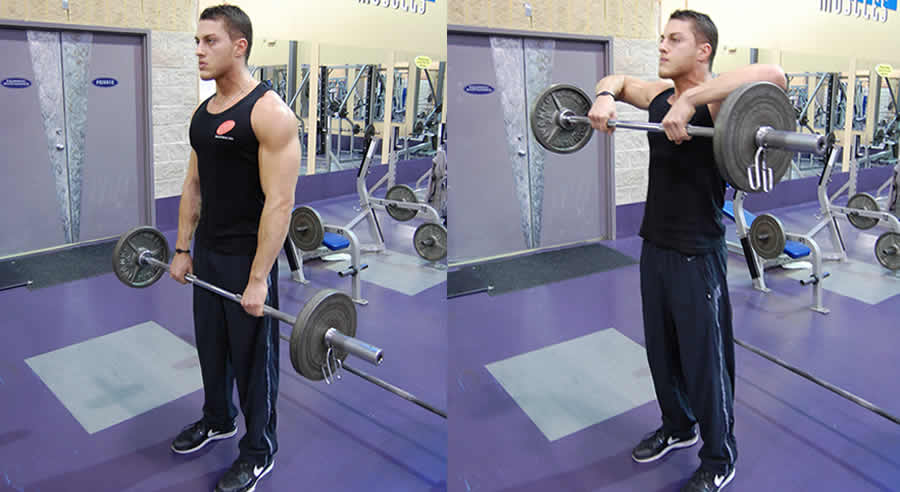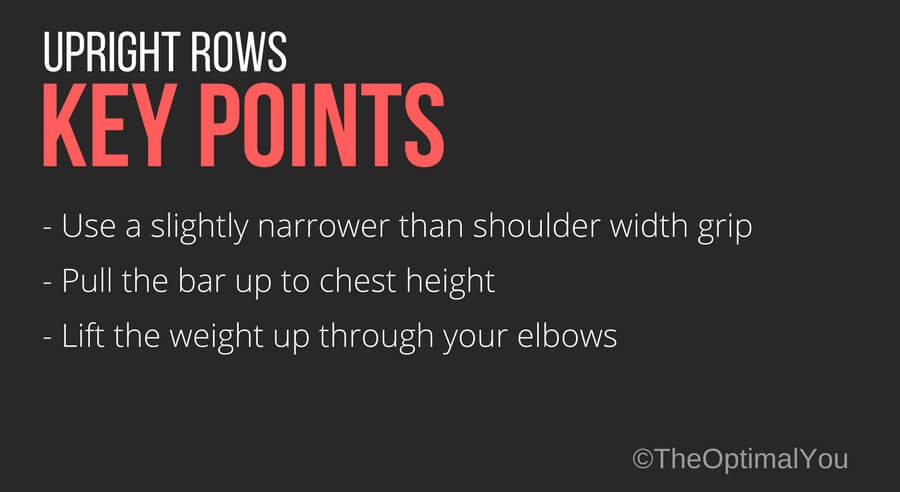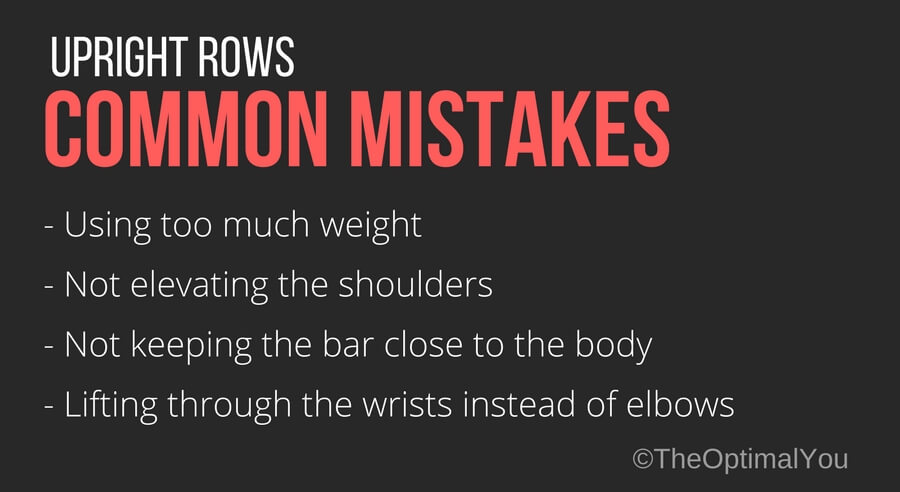Purpose of Upright Rows
The upright row is an exercise designed to target both the shoulders, and traps. You can modify how you do it to place greater emphasis on either the traps, or shoulders, and that should be based on your goal of why you’re doing it in the first place.
Equipment Needed for Upright Rows
All you need to perform traditional upright rows is a barbell – either a straight bar, or EZ-Bar can be used, which you choose should be based on preference, and practicality, as they both provide the same benefits, and come with the same costs.
Difficulty of Upright Rows
On a scale of 1 to 5, the upright row would rank around a 2, as it’s a pretty simple movement, although it does come with its own specific risks if not done right, or done poorly.
How to Perform Upright Rows
To perform an upright row, grab onto a barbell with a slightly narrower than shoulder width grip and pull it up to chest height, or slightly above. Focus on elevating the shoulders as you lift by shrugging your traps – this reduces the promotion of shoulder impingement. Keep the bar close to the body by allowing the elbows to flare out to the side. No pause is necessary at the top, as that further increases promotion of shoulder impingement, so just allow the movement to reverse after reaching the optimal height.
Key Points When Performing Upright Rows
- Use a slightly narrower than shoulder width grip – straight bar, or EZ-Bar is suffice
- Pull the bar up to chest height, or slightly above, allowing the elbows to flare out to the side as the bar is raised
- Make sure you are lifting up through your elbows
- Reverse the movement after reaching the desired height, no need to pause at the top in the most compromising positon of this already risky exercise
How Many Reps When Performing Upright Rows
Because of the added risk of shoulder impingement, heavy weights are not ideal when performing upright rows – this just leads to performing a more explosive Olympic-like pull, which is fine if that’s what you’re after, it just isn’t an upright row in its truest form anymore if you do that. Because of this, lower weight, and higher (more controlled) reps are ideal, so anything that allows you to perform 8-12 reps is suffice – more than 12 increases fatigue which could then decrease your ability to properly perform the exercise, thus defeating the purpose.
Common Mistakes When Performing Upright Rows
Some of the more common mistakes when performing are:
- Using too much weight – heavier weights promote momentum to be used which turns the upright row into more of an Olympic-like pull. The momentum is generally produced from the lower body, limiting the amount of work to be done by the muscles of the shoulder girdle, which is likely the areas you wanted to target in the first place when choosing this exercise.
- Not elevating the shoulders – keeping the shoulders down results in less space for the upper arm bone to move (termed “sub-acromial space”), often resulting in shoulder impingement
- Not keeping the bar close to the body – if the bar drifts forward, the stress is transferred onto other areas, which is fine if that’s what you’re after, but it’s no longer an upright row in its truest form
- Lifting through the wrists and not the elbows – it is important to raise the bar by lifting up through the elbows and not the wrists. Your elbows should be higher than the rest of your arms at the top of the rep.
Modifications to Upright Row
The primary modification you can choose to make when performing upright rows has to do with grip width. A wider grip lessens the range, but promotes a greater flaring of the elbows, which mimics performing a lateral raise, only using a barbell as opposed to dumbbells. While you could go narrower, it’s not always ideal, as it only increases the likeliness of shoulder impingement.
When to Perform Upright Rows
Because upright rows target a vast amount of musculature throughout the shoulder girdle, they are generally best suited for finishing off a back, or shoulder workout. You will likely never see, or hear of anyone starting a workout with this exercise, irrespective of what they are training. This doesn’t mean it’s not a worthwhile exercise, just that it is most commonly performed later in a workout.
Another reason for putting them near the end is due to them not lending themselves well to heavy weights, so since lighter is preferred, doing them at the end will result in the same benefits, but much less risk.
Alternatives to Upright Row
An effective alternative to the upright row performed with a barbell would be the upright cable row, using an attachment on a low cable pulley. The pulley allows you to modify the direction the resistance is coming from, and the rope provides a more natural movement at the wrist joint. With a barbell, the direction the resistance is going will always be down, whereas with a cable, you can adjust it to more effectively stimulate different regions – after a certain height though it becomes more of a row, than an upright row. If the resistance is at, or below, a 45 degree angle in relation to the floor, then it would still be considered an upright row.
Upright Rows (barbell) vs. Upright Cable Rows (rope)
While the barbell offers greater practicality (in that all you need is a barbell), upright cable rows offers less strain on the wrist, and potentially the shoulder as well. In either case, the mechanics of the movement remain the same – irrespective of whether you are using a barbell, or a rope attached to a low cable pulley, you still hike the shoulders up as you lift the weight to minimize shoulder impingement.



